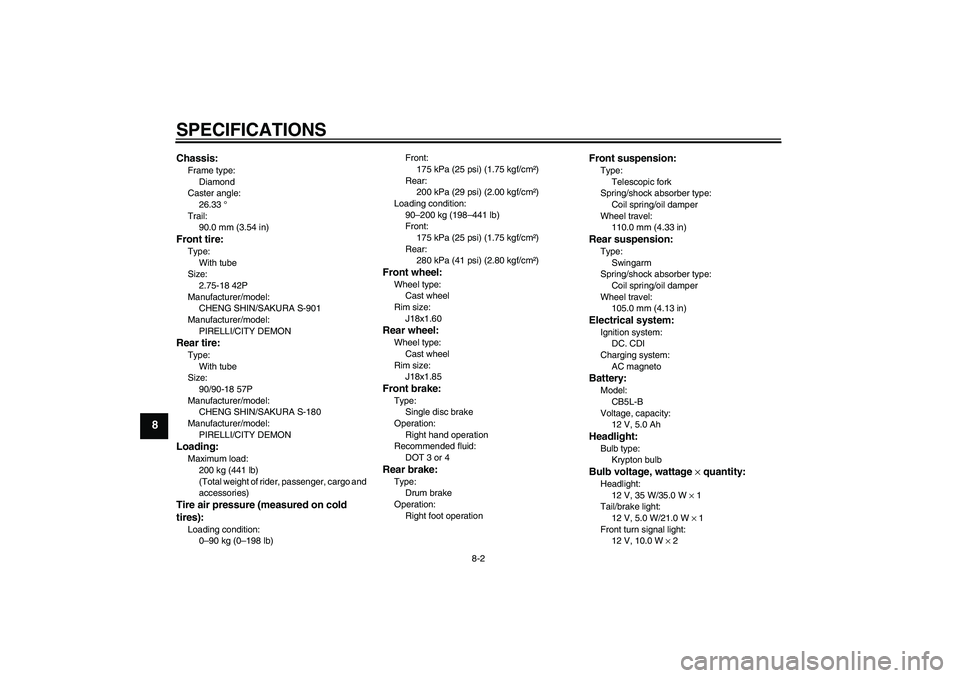Page 15 of 84

INSTRUMENT AND CONTROL FUNCTIONS
3-1
3
EAU10460
Main switch/steering lock The main switch/steering lock controls
the ignition and lighting systems, and is
used to lock the steering. The various
positions are described below.
EAU33590
ON
All electrical circuits are supplied with
power; the meter lighting, taillight and
auxiliary light come on, and the engine
can be started. The key cannot be re-
moved.NOTE:The headlight comes on automatically
when the engine is started and stays on
until the key is turned to “OFF”, even ifthe engine stalls.
EAU10660
OFF
All electrical systems are off. The key
can be removed.
EAU10680
LOCK
The steering is locked, and all electrical
systems are off. The key can be re-
moved.
To lock the steering1. Turn the handlebars all the way to
the left.
2. Push the key in from the “OFF” po-
sition, and then turn it to “LOCK”
while still pushing it.
3. Remove the key.To unlock the steering
Push the key in, and then turn it to
“OFF” while still pushing it.
WARNING
EWA10060
Never turn the key to “OFF” or
“LOCK” while the vehicle is moving,
otherwise the electrical systems will
be switched off, which may result in
loss of control or an accident. Make
sure that the vehicle is stopped be-
fore turning the key to “OFF” or“LOCK”.
1. Push.
2. Turn.
1. Push.
2. Turn.
U3D9E0E0.book Page 1 Saturday, December 25, 2004 11:35 AM
Page 69 of 84

PERIODIC MAINTENANCE AND MINOR REPAIR
6-37
6 6. Remove the axle nut, and then pull
the wheel axle out.
7. Push the wheel forward, and then
remove the drive chain from the
rear sprocket.
NOTE:The drive chain does not need to be
disassembled in order to remove andinstall the wheel.
8. Remove the wheel.
EAU37191
To install the rear wheel
1. Install the wheel by inserting the
wheel axle from the left-hand side.
2. Install the drive chain onto the rear
sprocket.
3. Install the axle nut.
4. Install the brake rod onto the brake
camshaft lever, and then install the
brake pedal free play adjusting nut
onto the brake rod.
5. Connect the brake torque rod to
the brake shoe plate by installing
the bolt and nut.
6. Adjust the drive chain slack. (See
page 6-22.)7. Take the motorcycle off the center-
stand so that the rear wheel is on
the ground.
8. Tighten the brake torque rod nut
and axle nut to the specified
torques.
9. Insert a new cotter pin.
10. Adjust the brake pedal free play.
(See page 6-18.)
WARNING
EWA10660
After adjusting the brake pedal free
play, check the operation of thebrake light.
EAU25850
Troubleshooting Although Yamaha motorcycles receive
a thorough inspection before shipment
from the factory, trouble may occur dur-
ing operation. Any problem in the fuel,
compression, or ignition systems, for
example, can cause poor starting and
loss of power.
The following troubleshooting chart
represents a quick and easy procedure
for checking these vital systems your-
self. However, should your motorcycle
require any repair, take it to a Yamaha
dealer, whose skilled technicians have
the necessary tools, experience, and
know-how to service the motorcycle
properly.
Use only genuine Yamaha replace-
ment parts. Imitation parts may look like
Yamaha parts, but they are often inferi-
or, have a shorter service life and can
lead to expensive repair bills.
Tightening torques:
Brake torque rod nut:
19 Nm (1.9 m·kgf, 13 ft·lbf)
Axle nut:
91 Nm (9.1 m·kgf, 66 ft·lbf)
U3D9E0E0.book Page 37 Saturday, December 25, 2004 11:35 AM
Page 70 of 84

PERIODIC MAINTENANCE AND MINOR REPAIR
6-38
6
EAU25962
Troubleshooting chart
WARNING
EWA10840
Keep away open flames and do not smoke while checking or working on the fuel system.
Check the fuel level in
the fuel tank.1. Fuel
There is
enough fuel.
There is
no fuel.
Check the compression.
Supply fuel.
The engine does not start.
Check the compression.
Operate the
electric starter.2. Compression
There is compression.
There is no compression.
Check the ignition.
Have a Yamaha dealer
check the vehicle.
Remove the spark plug
and check the electrodes.3. Ignition
Wet
Dry
Wipe off with a dry cloth and correct the
spark plug gap, or replace the spark plug.
Have a Yamaha dealer check the vehicle.
The engine does not start. Have a
Yamaha dealer check the vehicle.The engine does not start.
Check the battery.Open the throttle halfway and
operate the electric starter.
Operate the
electric starter.4. Battery
The engine turns over
quickly.
The engine turns over
slowly.
The battery is good.Check fluid, recharge,
check connections.
U3D9E0E0.book Page 38 Saturday, December 25, 2004 11:35 AM
Page 76 of 84

SPECIFICATIONS
8-2
8
Chassis:Frame type:
Diamond
Caster angle:
26.33 °
Trail:
90.0 mm (3.54 in)Front tire:Type:
With tube
Size:
2.75-18 42P
Manufacturer/model:
CHENG SHIN/SAKURA S-901
Manufacturer/model:
PIRELLI/CITY DEMONRear tire:Type:
With tube
Size:
90/90-18 57P
Manufacturer/model:
CHENG SHIN/SAKURA S-180
Manufacturer/model:
PIRELLI/CITY DEMONLoading:Maximum load:
200 kg (441 lb)
(Total weight of rider, passenger, cargo and
accessories)Tire air pressure (measured on cold
tires):Loading condition:
0–90 kg (0–198 lb)Front:
175 kPa (25 psi) (1.75 kgf/cm²)
Rear:
200 kPa (29 psi) (2.00 kgf/cm²)
Loading condition:
90–200 kg (198–441 lb)
Front:
175 kPa (25 psi) (1.75 kgf/cm²)
Rear:
280 kPa (41 psi) (2.80 kgf/cm²)
Front wheel:Wheel type:
Cast wheel
Rim size:
J18x1.60Rear wheel:Wheel type:
Cast wheel
Rim size:
J18x1.85Front brake:Type:
Single disc brake
Operation:
Right hand operation
Recommended fluid:
DOT 3 or 4Rear brake:Type:
Drum brake
Operation:
Right foot operation
Front suspension:Type:
Telescopic fork
Spring/shock absorber type:
Coil spring/oil damper
Wheel travel:
110.0 mm (4.33 in)Rear suspension:Type:
Swingarm
Spring/shock absorber type:
Coil spring/oil damper
Wheel travel:
105.0 mm (4.13 in)Electrical system:Ignition system:
DC. CDI
Charging system:
AC magnetoBattery:Model:
CB5L-B
Voltage, capacity:
12 V, 5.0 AhHeadlight:Bulb type:
Krypton bulbBulb voltage, wattage × quantity:Headlight:
12 V, 35 W/35.0 W × 1
Tail/brake light:
12 V, 5.0 W/21.0 W × 1
Front turn signal light:
12 V, 10.0 W × 2
chapter8 Page 2 Friday, January 7, 2005 4:05 PM